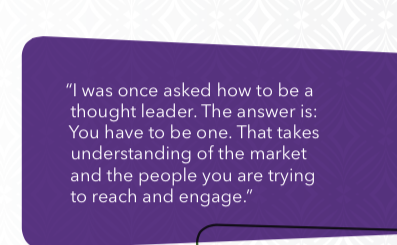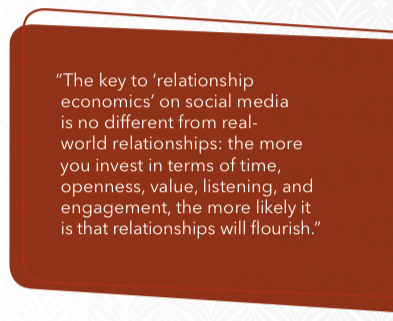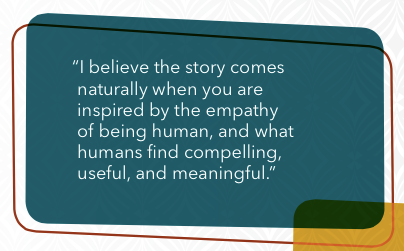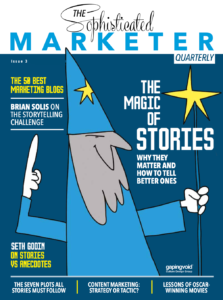LinkedIn and I have worked on several research projects together over the years ranging from the future of Native Advertising (private) to the state of Relationship Economics. Now, we banded together once again to explore the art and science of thought leadership. Although this time, I was on the contributing side of the research project and Jason Miller, LinkedIn’s senior manager of content marketing, was the lead.
Thought leadership is one of those things that’s easier to talk about than it is to achieve. I see it as a state, something earned, and not necessarily something you simply do. Smart thinking or communication or publishing does not necessarily equate to thought leadership. It’s own people value it on the other side of your work that sets the stage for something great.
According to Miller, “Thought leadership is an essential part of any successful content marketing strategy. Both B2C and B2B companies can benefit from the many advantages of thought leadership to build a more competitive reputation and ultimately drive more revenue.”
Miller along with his team at LinkedIn interviewed several experts to assemble a gorgeous and useful ebook to help brand marketers learn how to optimize thought leadership strategies. Experts include Joe Chernov, Ekaterina Walter, Shannon Stubo, among others. You can download it here.
To celebrate the launch of the new ebook, LinkedIn gave me the go ahead to share my part with you here.
Hope it helps!
How important is thought leadership for gaining a competitive advantage?
If you define thought leadership as thinking about people and how to provide these people with value, how to help them solve problems, and how to help them achieve aspirations and goals, it’s absolutely critical. If you define thought leadership as personal branding, the opposite is true. People often confuse thought leadership with personal branding. There’s a difference.
For those looking to create thought leadership content for the first time, what are the best opportunities to get started?
I was once asked how to be a thought leader. The answer is: You have to be one. That takes understanding of the market and the people you are trying to reach and engage. You have to understand the state of the world, and also have ideas on how it should evolve. But it starts by being human. This is a part even successful thought leaders miss, and it’s mostly driven by ego: “I’m better than the voices that are out there, so I’m going to add mine.”
True thought leadership starts with empathy. Can you tell me the top ten problems your audience has at any given time? How about the top ten aspirations? Are you thinking through where your audience wants to be, compared with where the market is going? That’s what inspires me. Someone who is honestly trying to better understand the people they are trying to help. And if understanding and helping is the goal, I don’t believe true thought leaders would call themselves thought leaders.
Can you think of a brand that is nailing thought leadership? What are they doing right? What are they gaining from it?
For a while American Express Open Forum was one of the best examples because they didn’t just try to put their own voice out there. They made it a point to bring in relevant outside voices. Their model became the benchmark, as did Mayo Clinic’s when they offered thought leadership by helping people answer common questions about health conditions. Same with H & R Block and their selfless approach to answering questions. When you are selfless as a brand, when you are providing value, the natural response is reciprocity. Reciprocity can lead to ROI.
Intel (client) has catered to the B2B audience as well as B2C which is pretty stellar for a semi-conductor company. They continue to break ground, using new and existing channels in leading ways, and demonstrating to the rest of the world what is possible.
What LinkedIn marketing tactics can brands use to implement thought leadership campaigns?
Recently, Altimeter Group (where I am a principal analyst) and LinkedIn partnered on a research project that ultimately showed how genuine communication and engagement in social media helps businesses improve relationships with both customers and employees. The key to ‘relationship economics’ on social media is no different from real-world relationships: the more you invest in terms of time, openness, value, listening, and engagement, the more likely it is that relationships will flourish.
It starts at the top. We found that executives at companies that reap the rewards of social media engagement are much more active on social media than executives at companies that are not socially active. They also play a bigger role in driving a socially engaged culture. Yes, there are specific tactics companies can use on
LinkedIn, but the most effective social media strategies are derived from a culture of relationship building where the executives lead by example.
You’ve mentioned before that engagement is really about A.R.T. (Actions, Reactions and Transactions). When crafting a thought leadership strategy, do you recommend starting with the story you want to tell or the A.R.T. you want to achieve?
A.R..T. is less about following the trend of trying to be a storyteller, and more about just trying to be engaging. I believe the story comes naturally when you are inspired by the empathy of being human, and what humans find compelling, useful, and meaningful. Most brands think about one audience, one campaign, and one emotion, but there are so many types of emotional elements to consider. The culture of each social network is different. Each channel features different people, with different needs and motivations, in a different context. The actual story is the bigger purpose or aspiration. And it unfolds in so many different ways, like the movie Crash. More companies need to think like that.
A.R.T. is really about what happens next. Everyone should design for what happens next. Attention is precious. Once you have earned attention, it’s what you do with that attention that counts. Too many companies emphasize attention. They come up with amazing headlines, clever GIFs, and great infographics, but there is rarely a defined strategy to do something with attention once it is captured.
In your mind, what is the biggest differentiator between those who try to become thought leaders and those who ultimately succeed at it?
Philosophically I wonder if anyone really knows if they are successful. How do you define success? The people who want to be helpful, do they have to justify ROI? It comes down to campaign vs continuum. One turns off and the other is part of life. The A.R.T. of engagement was always about assessing the value in real-time, adding to what you’re doing, and measuring. You should know more as you go, so that you can effectively refine as you go.
There are too many content marketers who suffer from mediumism and there are too few strategists who can turn attention into a human moment. It’s about designing for the embrace, not the channel, and then for the journey.
Connect with me…
Twitter | LinkedIn | Facebook | Google+ |Youtube | Instagram | Pinterest











thanks for your interesting post! ? Are you a successful content marketer?
As always, I think that you hit the nail right on the head. Authenticity is what people are looking for in real life and on social media. No longer can you simply tell people what to think, you need to use social media to engage and interact with people if you want to see a relationship flourish there. I think the term ‘thought leader’ is just another way of saying the same thing that is true again and again- engage and empathize with people in a genuine way and the outcome will almost always be a positive one. Great article and I’m definitely going to check out the e-book!
Thank you Stephanie. Great comment.
excellent, excellent, excellent
thank you thank you thank you
As someone who has been providing “Thought Leadership” strategy for clients over many years, long before the virtual world of today’s content marketing, I must add to this interesting dialogue that I believe Thought Leadership is clearly not for everyone. Nowadays, everybody has “thoughts” they think should be heard when, in reality, they should not be. Recently a younger colleague used the term “shovelware” – referring to content for content’s sake (visit stats; favorite numbers; page visits, etc.). How right on! There’s too much shovelware out there that says really nothing when you actually read it. And it fails miserably in actually creating engagement on a continuum. We are in the evolutionary curve of content marketing where everyone wants to get into the game. But too many executives want to be ‘TLs’ without first having done the heavy lifting of substantive leadership on the ground level, brick by brick, in the real world of everyday business operations and success. Real Thought Leadership is about market impacting, trend affecting, paradigm-defining insights that often are grounded in qualitative research and insights combined with real (not virtual) results that then imbues your ideas with the credibility to drive change.
This should be a post unto itself…